
Claus Georg Stabe PAN - PALLADIUM AT NIGHT
Berlin 26 Apr – 8 Jun 2019
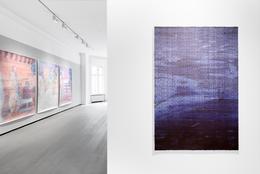
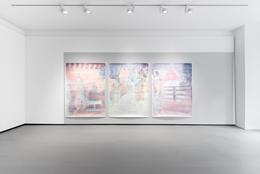
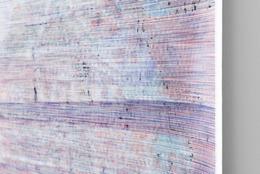
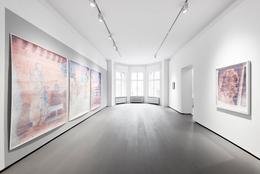
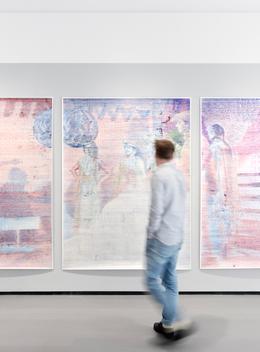
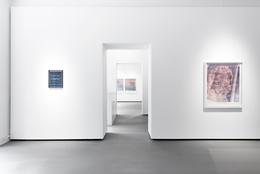
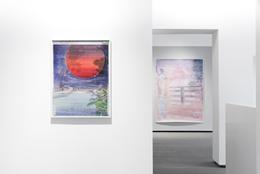
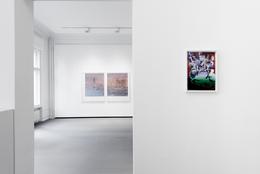
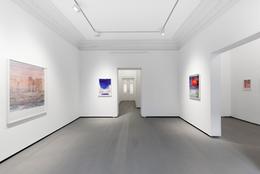
There is an infamous saying that all cats are grey at night. That shall express, that there are no visual differences in darkness. An exception is the sky itself. There stars can sparkle, airplanes can be confused with shooting stars and the different Moon phases can ultimately influence the brightness of the night. The most extraordinary event that can take place in the night sky, however, is the Blood Moon. This occurs when the Moon, the Earth and Sun align perfectly on the same axis, thus leaving the Moon entirely in the shadow of the Earth. Suddenly the night is not so grey any more, but an orange-red circle lights up the sky. The lunar eclipse also appears repeatedly in the works of Claus Georg Stabe. It arises from the darkness of the night in Seething Center (2018), illuminating its surroundings, and is even reflected in them. In Palladium at Night II (2019), on the other hand, the phenomenon’s dissipation becomes visible, with a bright green gently pushing the deep red aside. The title of the work, which is also the eponym of Stabe's current exhibition at REITER, appropriately refers to same-named secret US communications satellite. Floating in orbit since 2009, its purpose has never been publicly announced.
While the intensity of the Blood Moon depends on the degree of shadow the Earth casts on the Moon, Stabe's strong colour results from the precise technique on which his drawings are based. Contrary to what one might expect at first glance, they consist of thousands of lines extending horizontally and vertically across the pictorial space. Here the spacings vary not only from drawing to drawing, but also within a picture: tight lines produce a flat surface, so that concrete motifs may emerge; airy distances create dynamics that make the overall picture appear fluid. But each picture is preceded by a sketch and a concept, which is then transferred into the final drawing using ballpoint pen and ruler.
In Claus Georg Stabe's drawings, the lines don’t go for a walk (1), they don’t get lost on unknown paths, but have a clear goal and run focused towards it. However, it becomes especially interesting when the lines meet each other halfway and the monochrome pen marks mix with each other. The overlapped ink then produces not only new colours but also an extended moiré effect, and the resulting grids seem almost digital. In the same way that these patterns create a marbling effect, the eye is also deceived when the Earth obscures the Moon from direct sunlight making it appear blood-red. Something new emerges from the interference and this is precisely where the power of these pictures lie. They are a rejection of a traditional understanding of drawing. Be it in the means by which they are produced, the techniques with which they function, or the motifs that are depicted. For this reason, Claus Georg Stabe's drawings will probably never contain grey cats, but rather pink cockatoos if at all (The Silent Guest II, 2017) - and that is is exactly how it should be.
Text: Carina Bukuts
(1) Drawing is taking a line for a walk – Paul Klee
While the intensity of the Blood Moon depends on the degree of shadow the Earth casts on the Moon, Stabe's strong colour results from the precise technique on which his drawings are based. Contrary to what one might expect at first glance, they consist of thousands of lines extending horizontally and vertically across the pictorial space. Here the spacings vary not only from drawing to drawing, but also within a picture: tight lines produce a flat surface, so that concrete motifs may emerge; airy distances create dynamics that make the overall picture appear fluid. But each picture is preceded by a sketch and a concept, which is then transferred into the final drawing using ballpoint pen and ruler.
In Claus Georg Stabe's drawings, the lines don’t go for a walk (1), they don’t get lost on unknown paths, but have a clear goal and run focused towards it. However, it becomes especially interesting when the lines meet each other halfway and the monochrome pen marks mix with each other. The overlapped ink then produces not only new colours but also an extended moiré effect, and the resulting grids seem almost digital. In the same way that these patterns create a marbling effect, the eye is also deceived when the Earth obscures the Moon from direct sunlight making it appear blood-red. Something new emerges from the interference and this is precisely where the power of these pictures lie. They are a rejection of a traditional understanding of drawing. Be it in the means by which they are produced, the techniques with which they function, or the motifs that are depicted. For this reason, Claus Georg Stabe's drawings will probably never contain grey cats, but rather pink cockatoos if at all (The Silent Guest II, 2017) - and that is is exactly how it should be.
Text: Carina Bukuts
(1) Drawing is taking a line for a walk – Paul Klee
Artists